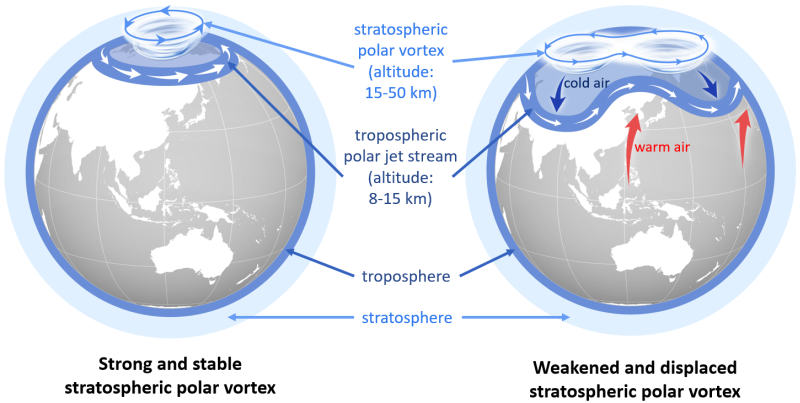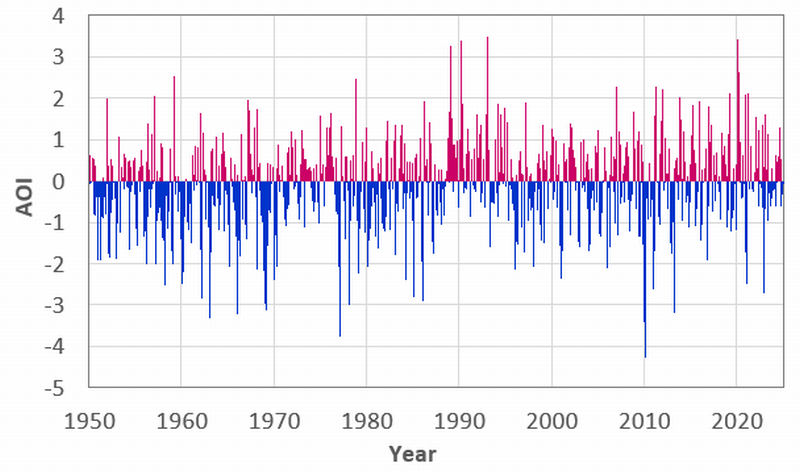The Relationship between Winter Weather, the Polar Vortex, and the Arctic Oscillation
The Relationship between Winter Weather, the Polar Vortex, and the Arctic Oscillation
CHAN Man-yee Eliza, TSE Wai-po
June 2025
Polar Vortex
The term “polar vortex” generally refers to the stratospheric polar vortex in atmospheric science. It is different from the more commonly known tropospheric polar jet stream[1], [2], [3].
The stratospheric polar vortex is a very large vortex of planetary scale over the polar regions between about 15 and 50 kilometers above the Earth's surface. It appears from autumn through spring, due to the temperature gradients between the poles and the mid-latitudes. This polar vortex is observed both in the Northern and Southern Hemispheres. The stratospheric polar vortex can affect surface weather patterns via the interactions between the stratosphere and the troposphere. In general, when the stratospheric polar vortex is strong and stable, the extremely cold air is generally confined to the polar regions. When the polar vortex weakens or becomes displaced, surface cold air from the polar regions spills southward and affects the mid-latitudes in the Northern Hemisphere more easily.

Figure 1 Stratospheric polar vortex and tropospheric polar jet stream.
Arctic Oscillation
Arctic Oscillation (AO), also called Northern Annular Mode (NAM), reflects the fluctuation in sea level atmospheric pressure between the Arctic and the mid-latitude regions in the Northern Hemisphere[4], [5]. There are two phases of AO. In the positive phase, the air pressure over the Arctic is generally lower-than-normal while the air pressure over the mid-latitudes is higher-than-normal. The tropospheric polar jet stream more often shifts north. Moreover, a strong stratospheric polar vortex over the Arctic is often linked to the positive phase of AO. During this phase, the frigid cold air mass is mostly kept from spreading southwards, with mid-latitude regions experiencing milder winters.
In contrast, when in the negative phase, the Arctic air pressure is higher-than-normal and the mid-latitude pressure is lower than normal. The polar jet stream is generally more wavy and dips farther south. A weakened or displaced Arctic polar vortex is usually associated with the negative phase of AO. In this phase, winter cold air outbreaks are more likely to affect the mid-latitudes and may bring bitterly cold weather to the affected areas.

Figure 2 Arctic Oscillation Index (AOI). Data source: NOAA
Relationship between AO and winter temperature in Hong Kong
Some research studies indicate that the positive phase of AO is linked to weaker East Asian winter monsoon, while cold surges over East Asia tend to be stronger during the negative phase of AO[6]. However, as southern China is located at the far southeast of the Asian continent, the impact of AO on the winter temperature of southern China may not be so straightforward. Whether a cold surge can affect southern China will very much depend on the location of the outbreak of cold air (i.e., which continent), the movement path of the cold air and the weather conditions on the route. Taking Hong Kong as an example, past statistics suggest that the correlation between the monthly mean temperature of Hong Kong and the AO index (AOI) is not significant. Moreover, if past events with AOI at or below -3 and the minimum temperature at Hong Kong in the ensuing 7 days between December and March since 1950 are considered, only 7% of these events brought very cold weather (daily minimum temperature at or below 7℃) to the territory while over 45% of them did not have cold weather to follow, hinting that the strong negative phase of AO does not necessarily imply the occurrence of severe cold weather in Hong Kong.
References:
[1] Darryn W. Waugh, Adam H. Sobel, and Lorenzo M. Polvani (2017). What Is the Polar Vortex and How Does It Influence Weather?. Bulletin of the American Meteorological Society, 98(1), 37-44.
[2] Gloria L. Manney, et. al. (2022). What's in a Name? On the Use and Significance of the Term “Polar Vortex”. Geophysical Research Letters, 49(10).
[3] NOAA Climate.gov. Welcome to the Polar Vortex Blog!
[4] HKO - Arctic Oscillation AO.
[5] NOAA Climate.gov. Climate Variability: Arctic Oscillation.
[6] 龚道溢,王绍武,2003: 近百年北極濤動對中國冬季氣候的影響,地理學報,58(4),559-568。